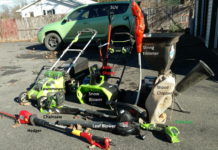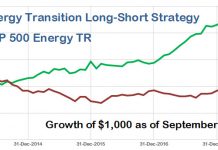UPDATE 3/4/2011: An up-to date article on selecting green mutual funds and ETFs can be found here.
Why Invest in Renewable Energy?
Given all the attention that renewable energy is getting in the news over the last couple years, investing in renewable energy has become a hot topic. People are drawn to renewable energy for one of several reasons:
- To fight Global Warming
- To prepare for Peak Oil.
- To improve Energy Security and local economies.
- To cash in on the above trends.
The beauty of investing in renewable energy companies is that these goals are not mutually exclusive. With one investment, the investor can feel good about what his money is doing for three reasons, while putting his money in what is proving to be a spectacular growth story.
How To Invest
For mutual fund investors, Renewable Energy focused mutual funds have been few and far between, but the recent growth of interest in the sector has lead to a plethora of new offerings. US investors can choose from load funds such as the New Alternatives Fund (NALFX) and Calvert Global Alternative Energy Fund (CGAEX) and the no-load Guinness Atkinson Alternative Energy Fund (GAAEX). Unfortunately, the load funds have expense ratios in excess of 1.25%, and the Guinness Atkinson fund’s ratio is 1.98%. Given these high expenses, I strongly prefer the industry ETFs.
The Powershares Wilderhill Clean Energy ETF (PBW) and NASDAQ Clean Edge U.S. Liquid Series ETF (QCLN) have expense ratios currently capped at 0.60%, high compared to a general energy sector ETF such as XLE (0.24%), but is a much more economical way to invest than the sector mutual funds. Unfortunately, both of these ETFs track US-based indices, and so provide little international diversification. The new Market Vectors Global Alternative Energy ETF (GEX), neatly solves this problem with a portfolio similar to the more diverse mutual funds, and an expense ratio of only 0.5%, which easily makes it my favorite fund in the space. Also recently launched, the Powershares Global Clean Energy Portfolio (PBD) has broader diversification into a greater number of small cap companies, but given its expense ratio of 0.75%, an investor with over $5,000 to put into the sector could closely replicate PBD by splitting his allocation 50-50 between GEX and PBW or QCLN.
Given the relatively high expenses of the sector ETFs, I believe it makes sense for investors who are looking to invest $25,000 or more in the sector for a period of years to build their own ETF from individual stocks gleaned from the holdings of the above ETFs and mutual funds. This also opens the possibility of focusing on established companies which are early movers into the renewable energy arena, a strategy which is less likely to lead to spectacular gains, but which also gives some protection against spectacular dot-com bust style losses. Investors seeking a greater international exposure could mix GEX with a smaller portfolio of domestic companies.
UPDATE: 6/29/08 There are now also Solar and Wind ETFs (click for discussion)
Picking Individual Stocks
Given the complex nature of the technologies, and the sparse coverage of many of the companies by industry analysts, there is still considerable room for active management in the sector. Many investors buy Renewable Energy stocks for emotional reasons, so an understanding of practical behavioral finance may lead to excellent buying opportunities in quality companies.
Many development stage renewable energy companies have declined considerably in the recent market correction triggered by the fallout from the US subprime mortgage market. If market uncertainty continues, investors who bought these companies in response to excitement about their growth prospects will likely lose their nerve. An understanding of the business models and technologies in the industry should provide the knowledgeable investor with the tool to differentiate the undervalued quality companies from the cheap trinkets that have been finally recognized for what they are.
EDITORIAL NOTE: Currencies
This article was first published in UK-based The Price Report, issue 13, published by Tim Price, Chief Investment Officer for Global Strategies at UBP in London. He added his own editorial note:
The one caveat to the renewable energy company, fund and
ETF story is that these investments are invariably denominated in US dollars.
As a longer term dollar bear, I believe it makes sense to hedge this currency
risk where possible. It is an inevitable by-product of commodity investing in
that pretty much all commodities are denominated in dollars. Sterling-based
investors who share my currency views would be advised to mitigate this dollar
risk, either by limiting their overall portfolio exposure to dollar assets, by
hedging their foreign currency risk through sales of currency forward
contracts where achievable, or by finding a local currency version of these
funds – again where possible.
I agree with Mr. Price that the dollar will continue to be a weak
currency for the near future, which is one of the reasons I prefer GEX to PBW
and QCLN, because it contains fewer US-based companies. However, it is
important to note that the currency risk involved in buying a stock has very
little to do with the currency in which it is traded, but rather with the
currencies in which it does business. A company’s earnings (and hence its
long term stock price) will correlate
with its profits, and so a company’s share price should only suffer from a
declining dollar if it has more dollar based revenues than dollar based
expenses. A company with dollar based expenses and revenues mostly in
foreign currency (e.g. a US-based exporter) should actually benefit from a
declining dollar.
For this reason, people seeking to reduce dollar exposure should look for a
portfolio of global businesses; the country of listing is much less important
than the nature of the businesses.
I also disagree that commodity business
inevitably have dollar based commodity risk. Globally traded commodities
have long been an excellent hedge against currency risk, because, unlike currencies,
they represent something of intrinsic value, and hence are usually the best
hedge against all currencies. A glance at the above chart comparing
the PowerShares DB US Dollar Index Bullish (UUP)
to the Dow Jones AIG Commodity index (^DJC)
shows how this index has been an excellent hedge against the US dollar.
DISCLOSURE: Tom Konrad and/or his clients do not have positions in any securities mentioned, but GAAEX is an advertiser on AltEnergyStocks.
DISCLAIMER: The information and trades provided here are for
informational purposes only and are not a solicitation to buy or sell any of
these securities. Investing involves substantial risk and you should evaluate
your own risk levels before you make any investment. Past results are not an
indication of future performance.










Investing green is a smart idea and a lot of these companies are way more efficient than companies that WASTE. However you need to understand what you are buying like warren buffet has stated MAKE sure you know the company you buy like a business.
I am interested in investing in small companies tied to renewable energy. I am not sure how to go about this, what is the minimum investment?
many thanks, Lawrie
For publicly traded companies, there’s no minimum investment; you need a brokerage account, and to know what you’re investing in. We regularly feature small companies (here are ten))on our blog, and we also have an extensive renewable energy stock list which categorizes companies by sector.